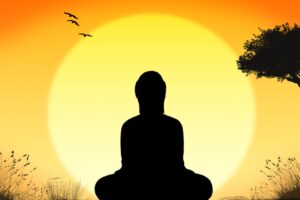
Zen is experiential in nature. Zen also includes re-experiencing Nature. I would like to invite you to join us in May in a highly intentional actualization of these truths. Plan to attend our annual Spring Retreat at Watershed, from Wednesday, May 2nd to Sunday, May 6th; pre-register soon to reserve your spot. The retreat is titled with its theme:
RETURN TO NATURE.
Watershed Retreat offers a hundred acres of Mother Nature’s finest.
This will be a deep dive into Nature. The nature of the natural world. The nature of the self. The nature of the “world of suchness,” in which “there is neither self nor other-than-self,” according to the foundational Ch’an poem “Trust in Mind,” Hsinhsinming (HHM). In our natural state, we “imperceptibly accord with all things,” according to Master Dogen: Fire, Wind, Water and Earth. “The Four Elements return to their natures just a child turns to its mother” (HHM). I urge you to return to your Original Nature (initial caps indicate Matsuoka Roshi’s reverence for this term).
And there is no gap between your original nature and Nature. Listen to the babbling brook and “enter there.” “Hear the true dharma” expounded by the wind in the trees. Embrace the “sounds of valleys and streams.” Witness the blue and green “mountains always walking” (re: Dogen).
Settle into solitary liberation deep in the heart of the forest. Witness the passage of time, in the moving shadows of trees, nature’s sundial. Slow down to the moment. Experience “Uji: Being-Time.” Reenter real time and space, through zazen.
Return to your natural self: Rediscover the natural sitting posture, the natural breath, and the natural state of your original mind. Remember the natural way to sit; the natural way to stand; the natural way to walk; to lie down, and to sleep under the stars.
Meditate “through the day, through the night” to realize Kanzeon, the all-seeing, all-hearing Bodhisattva of Compassion. Merge with the sun and moon; rising and setting, though they never really do. Realize “Sun-faced buddha; moon-faced buddha” (Master Baso Doitsu).
My poem for you:
Just between
red sun
white moon
my pink flesh
Rearrange in any order you wish: red sun; white moon; just between; my pink flesh.
When it comes to talking about Zen, it is difficult to find a simple way to discuss its irreducibly simple approach to meditation, and how that integrates with our daily life. As a professional designer, I cannot see any way to make zazen itself any simpler, except to avoid imbuing it with overly mystical, or philosophical, or even psychological, overlays. The Chinese-Japanese sitting cushion (J. zafu), as a designed item, is also pretty difficult to improve. I have made some inroads into the design details of sitting benches (J. seiza) that I consider to add value: making them collapsible and compact, and weighing half of what the run-of-the-mill designs currently available typically do. And one could certainly argue that the protocols and accessories around traditional Zen practice could be less elaborate. But we embrace these as our Zen heritage.
My coinage of Natural Zen, I think may be unique, when applied to the method of Zen itself. Whereas online, 13,900 results for “natural Zen” mostly yield ads for everything from music and food, to male-enhancement products. I mean this construction to point to the fact that even the traditional accretions around Zen are “natural,” in the sense that they reflect the transmission of Zen from India through China, Korea, Japan and the Far East. Zen assimilated into the indigenous cultures of the time, absorbing certain memes and rituals into the form of the practice. I find them interesting, and in many cases admirable, from an aesthetic perspective. Zen regards these as peripheral, not central, as indicated by Master Dogen in “Self-Fulfilling Samadhi,” Jijuyu Zammai (JJZ):
From the first time you meet a Master
without engaging in incense offering, bowing, chanting Buddha’s name,
repentance or reading scripture,
you should just wholeheartedly sit,
and thus drop away body and mind
Practicing Zen naturally is not really dependent upon the various traditions that have been handed down to us over the 2,500 years of its evolution. But it is natural to become a bit confused about the natural way to practice Zen, when confronted by all the various trappings we have inherited. I think that with time and repetition, any serious practitioner will see through the prevalent forms, to the underlying, primordial essence of Zen.
This process, actualized through repetition, I think, represents a kind of cultural adaptation, similar to sensory adaptation. Just like the weight of our clothes, such outward aspects slip into the subliminal, with enough repetition. Only when we are reminded of their presence, do they become objects of attention, or distraction. Much like the weight of our clothes, or our heartbeat.
If a stimulus is repetitive enough, our conscious mind simply ignores it. This, I think, is the very definition of ignorance, and illuminates what seems to be one of the main functions of the discriminating mind (S. citta). Any acknowledgment or recognition of relatively continuous phenomena is by exception. In the case of the heartbeat, for example, the only time we ordinarily become aware of it, is when it threatens to stop, or is exaggerated by exercise, emotion, or crisis. Awareness operates on a need-to-know basis.
In the context of our daily lives, the frenetic pace of activity, and constant information overload, begins to trigger this kind of immune response, on many levels. The hapless mind shuts down, becoming numb, in a last-ditch effort to cope with the barrage of stimulus coming at us moment-by-moment. Especially when we are in the thick of it, for example commuting on the expressway, or hurrying through a crowd to get to our daily destinations.
“The world is too much with us,” as William Wordsworth reminded us at the beginning of the industrial revolution, when we first started distancing ourselves from nature, becoming immersed in inchoate materialism. Or as Matsuoka Roshi would often say, “Civilization conquers us.”
We are so distant from Nature, that we need to do something unnatural — sitting for long periods of time, facing a blank wall — in order to get back to our normal, natural state. In the face of this reality, I feel justified in quoting myself (apologies to Barry Goldwater):
Extremity in the pursuit of moderation is no vice
We absorb so much punishment on a regular basis, and accumulate such a backlog of junk reality — cultural and personal baggage — that it takes forever just to divest ourselves of our own opinions, about everything that counts. Most of our memories are relatively trivial. Frankly, most of mine are not worth remembering. Your results may vary.
We can appreciate that Zen meditation (J. zazen) is designed to reboot our consciousness, refresh our monitor screen, and clean out our hard drive; just as our brain flushes waste organic matter during deep sleep. Zazen is literally hitting the refresh button on our brains and nervous system, five sense realms, and, most importantly, our thinking. One misconception regarding Zen is that it disparages thinking, suppressing the “monkey mind” during meditation. This is contradicted by the Ch’an poem (HHM):
To move in the One Way do not reject even the world of senses and ideas
Indeed accepting them fully is identical with true enlightenment
Far from being anti-intellectual, Zen develops true intelligence, a claim made by Master Dogen, if memory serves. In Zen, however, thinking is put in its proper place. This indicates a more modest appraisal of its value than is typical for Western thinking, where the thinking mind is the end-all and be-all: “Cogito ergo sum” as Rene Descartes expressed it. But citta, the analytical mind, is absolutely essential to living in the modern age, enabling us to get the good grades, compete for the better jobs, et cetera. In Zen, we do not underestimate, let alone dismiss, its importance.
But in Zen, we honor the other half of the mind, the wisdom part (S. bodhi). This is the side that does not rely on thinking so heavily, and that we conventionally regard as intuition. This trait is more emphasized in the so-called creative disciplines — the performance and plastic arts, music, theatre, dance, etc. — which are in my wheelhouse as a committed artist, professional designer, and amateur musician.
But this side of the mind is also highly regarded in higher mathematics, the sciences, and in literature in general. Intuition is at the heart of invention and innovation in business, as well, particularly as industry goes digital. We are just beginning to understand the ramifications of this cyber-revolution in how we live, and how we interact with the rest of the world. In this context, Zen is even more necessary than it was in Dogen’s time, or in Buddha’s.
You may argue that it is not necessary to travel to exotic places in order to do Zen, as I have in past writings, and as Master Dogen admonishes us in “Principles of Seated Meditation,” Fukanzazengi. But this does not suggest that “basement Zen,” or practicing in your own back yard, is necessarily superior to practicing in the wilderness. The original Order of monks and nuns in India meditated under the trees (J. sorin). And it is true that Master Dogen reminds us (JJZ) that, while:
Grass, trees and lands which are embraced by this teaching
together radiate a great light
and endlessly expound the inconceivable profound dharma
We don’t necessarily “hear the true dharma” (Dogen’s Vow, Eiheikosohotsuganmon), especially while within the confines of the city, where sitting outside is often not an option:
Grass, trees and walls bring forth this teaching for all beings
common people as well as sages
who in accord extend this dharma
for the sake of grass trees and walls
Not only Nature, but the works of humankind as well, expound the dharma. Emphasis mine above; walls point to the concrete expression of the buddhadharma in the form of monasteries, Zen centers, etc. But only people and sages who are in accord with the dharma can extend it for the sake of nature (grass trees) and people (walls). In other words, pay it forward.
The walls of the zendo are there to shelter us from the distractions of the busy world. Even in the woods, the buzzing of insects; snakes; a deer or bear; the strength of the wind and other vicissitudes of weather; can conspire to confuse and distract our mind, especially when our meditation is not yet mature. The great Indian saint of 1850s Calcutta, Sri Ramakrishna, said that in the beginning, meditation is like a seedling that needs a fence around it to prevent its trampling by elephants. But in time the seedling grows into a great oak, that even an elephant cannot knock over. Matsuoka Roshi said that eventually you will be able to sit in a thunderstorm, or even an earthquake.
Which brings us to the true nature of Zen, which is a worldwide phenomenon, or should be. Zen is not Indian, Chinese, Korean, Japanese, nor is it American. It is more fundamental than culture or custom. It is not merely another thing that we humans do to entertain ourselves, or to cope with existence. It is a returning to our fundamental nature, that which brought us into this existence to begin with. The local trappings of protocols are not a barrier to practice, nor are they absolutely indispensable to it. As our Soto Founder reminds in “Lancet for Zazen,” Zazenshin:
Intimacy without defilement
is dropping off without relying on anything
Verification beyond Absolute and Relative
is making effort without aiming at it
The natural intimacy of the mind and its objects is revealed within zazen. But it requires that we stop relying on anything that we think we need to get us there — our thoughts and opinions about reality get in the way. In terms of verifying this method to our own satisfaction, we have to give up whatever target, goal or objective we think we should be aiming at. This begins to describe the natural way to practice Zen, but it is not natural in the ordinary sense. In fact, it is counter-intuitive, and certainly counter-cultural.
But Master Dogen assures us that this is our true or Original Nature, in which we find no conflict with the other denizens of nature:
The water is clear to the earth
a fish is swimming like a fish
The sky is vast and extends to the heavens
a bird is flying like a bird
It is as natural as a fish in water, as a bird in the sky. But unless the fish swims, or the bird flies, it doesn’t work. The fish and the bird die, unless they do the work (Bendowa).
Zen doesn’t work — unless you work it. But in a world in which nothing else is working, Zen is our best and most reliable resort in the face of the intractable problem of existence. But as Matsuoka Roshi told me, when it comes to Zen practice, or enlightenment as the hoped-for outcome, mine is mine, and yours is yours. You can’t get mine and I can’t get yours. But I can get mine, and you can get yours, depending on whether or not we are willing to do the work. The work consists of:
Finding the natural posture. When we sit in zazen, we are simply returning to the most natural way to sit, comfortably, for long periods of time. This is also natural in that, before the invention of the chair (which probably began as a throne, elevating the tribal leader(s) above the hoi polloi), everyone sat on the ground, around the campfire, this way.
Following the natural breath. It is a bit difficult to accept that we are not already, always breathing naturally. Until we begin to recover the natural way to breathe in our meditation. Then it becomes apparent that ordinarily, we are not even aware of our breath, just as we do not normally hear our heart beating.
Realizing the natural mind. Note that the word “realize” means that this is not something we can “do,” exactly, but it is something that can happen. What we can work on, directly, are the posture and breath. Eventually the mind will have to come along.
Whether you make the effort at home, or at the retreat at Watershed, it is the same effort. I recommend that you do not approach this apparent choice as an “either-or” decision, but as a “both-and” opportunity. This way, you do not create artificial distinctions in Zen, as we tend to do with everything else in our lives.








